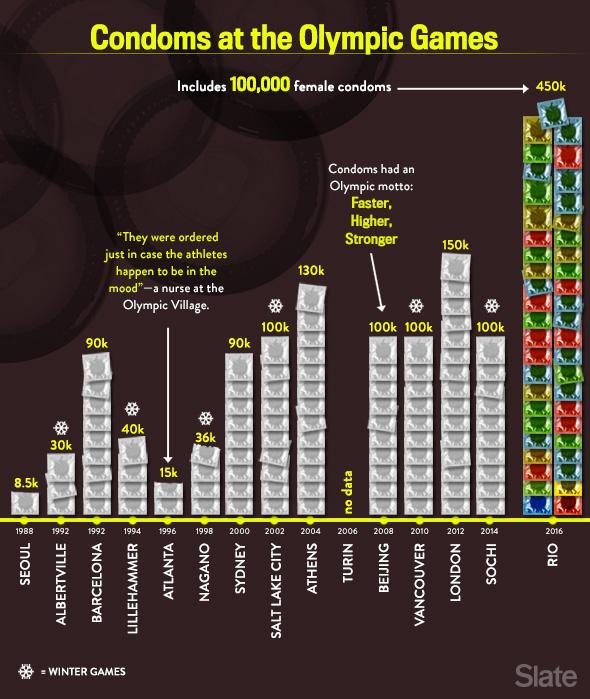Last week, the Brazilian newspaper Folha de São Paolo reported that a record-breaking 450,000 condoms would be provided for athletes at the Summer Games in Rio de Janeiro. Ever since the games’ condom count was first reported for the 1988 Olympics in Seoul—that number was 8,500—the press has dutifully recorded the size of the games’ latex supply. (The one exception: the 2006 Winter Games in Torino, for which figures were never released.) These numbers aren’t always parallel: Sometimes, media reports cite the amount of condoms distributed solely to athletes, while other numbers include those handed out to press and volunteers. The graphic below features our best estimate of the condom count for each Olympics since Seoul 1988, and we’ve shown our work at the bottom of the page.

Holly Allen/Slate
1988 Summer Olympics, Seoul: 8,500
1992 Winter Olympics, Albertville: 30,000
“Packs of three condoms are being distributed free to athletes and for a little less than $2 to others.” —New York Times, Feb. 5, 1992
1992 Summer Olympics, Barcelona: 90,000
“Officials laid in a supply of 90,000 condoms for the 16-day Games, and have dispensed well over half of them so far.” —Associated Press, Aug. 4, 1992
1994 Winter Olympics, Lillehammer: 40,000
Condoms “issued to athletes, officials, volunteers and journalists.” —Sydney Morning Herald, June 7, 1996
1996 Summer Olympics, Atlanta: 15,000
“ ‘They were ordered just in case the athletes happen to be in the mood,’ said Shirley Jenkins, a nurse at the Olympic village.” —the Mirror, July 16, 1996
1998 Winter Olympics, Nagano: 36,000
2000 Summer Olympics, Sydney: 90,000
“Sydney organizers thought that 70,000 would be enough. They were wrong and had to send out for 20,000 more.” —Today, Feb. 18, 2010
2002 Winter Olympics, Salt Lake City: 100,000
2004 Summer Olympics, Athens: 130,000
“Condom manufacturer Durex has donated the prophylactics as well as 30,000 sachets of lubricant … ‘to smooth the performance of the world’s elite sports people in the arena and under the covers,’ it said in a statement.” —Reuters, July 27, 2004
2006 Winter Olympics, Turin: unknown
“The Italian organizers have not said how many are available, only that athletes will easily find them if they want them.” —Seattle Times, Feb. 14, 2006
2008 Summer Olympics, Beijing: 100,000
“[O]rganizers brought in 100,000, all with the motto ‘faster, higher, stronger.’ ” —Huffington Post, April 24, 2010
2010 Winter Olympics, Vancouver: 100,000
“Lest anyone get the wrong idea, a spokesperson clarified that this total included condoms given out to security staff and volunteers, and in public bathrooms. The athletes got just 40,000, or a mere 6.2 apiece.” —Washington City Paper, Sept. 18, 2013
2012 Summer Olympics, London: 150,000
“Durex, the official Olympic supplier, has sent 150,000 condoms to the village.” —NPR, Aug. 8, 2012
2014 Winter Olympics, Sochi: 100,000
2016 Summer Olympics, Rio: 450,000
“About 450,000 condoms will be distributed during the Rio de Janeiro Olympics, three times more than for the London Games four years ago, the International Olympic Committee says. Part of the reason was because 100,000 female condoms will be available for the first time, along with 350,000 condoms for men. About 175,000 packets of lubricant are also being supplied.” —Associated Press, May 21, 2016
